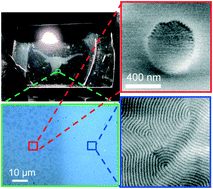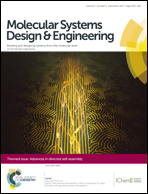Spatially-controllable and uniform photochemical transfer printing of block copolymer nanopatterns†
Abstract
Transfer printing processes with resolution approaching 10 nm are not very common because pattern fidelity is often lost due to translational motion of the patterning molecules. To overcome this challenge, we describe here a photochemical transfer printing (PTP) process in which covalent bonds are formed between a nanopatterned master film formed by self-assembled poly(styrene)-block-poly(methyl methacrylate) (PS-b-PMMA) and solution-deposited conformal layer poly(styrenesulfonylazide-alt-maleic anhydride) in the solid state, where the pattern is fully stable. The monolayer of grafted PS-b-PMMA is then transferred to an initially blank replica film using a photopolymerizable liquid conformal layer possessing very low viscosity (hexanedioldiacrylate, 9 cP), which is known to promote dimensional uniformity in UV nanoimprint technology. The chemical nanopatterns transferred to the replica substrate is continuous and robust enough to successfully direct the self-assembly of new PS-b-PMMA films cast upon it after thermal annealing. The experiments in this work demonstrate patterning resolution down to 14 nm half-periodicity. The PTP process is mechanistically controlled by light and therefore can be spatially controlled by photomasks.

- This article is part of the themed collection: Advances in Directed Self-Assembly


 Please wait while we load your content...
Please wait while we load your content...